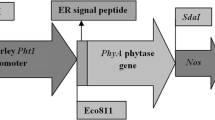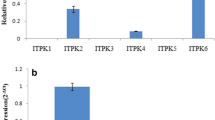Abstract
Phytic acid is the major source of phosphorus and other mineral bound compounds in many plant tissues especially seeds and bran of cereals. During germination, phytase enzyme degrades phytic acid and bound phosphate and minerals are released. The monogastric animal cannot digest phytate due to lack of the phytase enzyme. Considering that, we have generated low phytate rice by over expressing appA gene cloned from E. coli under the aleurone-specific promoter of maize zein gene. Molecular analysis confirmed the stable integration of transgene and plants were grown up to T3 generation. The T3 seeds showed around 45% decrease in seed phytate content with a fourfold increase of inorganic phosphorus (Pi) level. The enhanced iron and zinc was twofold and threefold respectively in polished seeds of transgenic plants. There was no change in germination behaviour and other morphological traits in transgenic seeds. Thus, this result provides evidence that tissue-specific expression of bacterial phytase can lead to the reduction of phytic acid in rice seeds without hampering its other physiological processes and phenotypic cost.





Similar content being viewed by others
Abbreviations
- appA :
-
Apoplastic periplasmic protein A
- imp :
-
Inositol mono phosphatase
- itpk :
-
Inositol 1,3,4 trisphosphate 5/6 kinase
- ipk1 :
-
Inositol 1,3,4,5,6 pentakisphosphate 2-kinase
- mips :
-
Myo-inositol phosphate synthase
- lpa :
-
Low phytic acid
References
Ali N, Paul S, Gayen D, Sarkar SN, Datta SK, Datta K (2013a) Development of low phytate rice by RNAi mediated seed-specific silencing of inositol 1,3,4,5,6-pentakisphosphate 2-kinase gene (IPK1). PLoS ONE 8(7):e68161
Ali N, Paul S, Gayen D, Sarkar SN, Datta SK, Datta K (2013b) RNAi mediated down regulation of myo-inositol-3-phosphate synthase to generate low phytate rice. Rice 6:12
Bilyeu KD, Zeng P, Coello P, Zhang ZJ, Krishnan HB, Bailey A, Beuselinck PR, Polacco JC (2008) Quantitative conversion of phytate to inorganic phosphorus in soybean seeds expressing a bacterial phytase. Plant Physiol 146:468–477
Bradford MM (1976) A rapid and sensitive method for the quantitation of microgram quantities of protein using the principle of protein-dye binding. Anal Biochem 72:248–254
Bregitzer P, Raboy V (2006) Effects of four independent low-phytate mutations on barley agronomic performance. Crop Sci 46:1318–1322
Chappell AS, Scaboo AM, Wu X, Nguyen H, Pantalone VR, Bilyeu KD (2006) Characterization of the MIPS gene family in Glycine max. Plant Breed 125:493–500
Chen PS, Toribara TY, Warner H (1956) Microdetermination of phosphorus. Anal Chem 28:1756–1758
Chhetri DR, Mukherjee AK, Adhikari J (2006) Myo-inositol content in pteridophytes and the isolation and characterization of l-myo-inositol-1-phosphate synthase from Diplopterygium glaucum Braz. J Plant Physiol 18:291–298
Datta K, Vasquez A, Tu J, Torrizo L, Alam MF, Oliva N, Abrigo E, Khush GS, Datta SK (1998) Constitutive and tissue specific differential expression of cryIA(b) gene in transgenic rice plants conferring resistance to rice insect pest. Theor Appl Genet 97:20–30
Datta K, Koukolikova-Nicola Z, Baisakh N, Oliva N, Datta SK (2000) Agrobacterium mediated engineering for sheath blight resistance of indica rice cultivars from different ecosystems. Theor Appl Genet 100:832–839
Doria E, Galleschi L, Calucci L, Pinzino C, Pilu R, Cassani E, Nielsen E (2009) Phytic acid prevents oxidative stress in seeds: evidence from a maize (Zea mays L.) low phytic acid mutant. J Exp Bot 60:967–978
Feng X, Yoshida KT (2004) Molecular approaches for producing low-phytic-acid grains in rice. Plant Biotechnol 21:183–189
Gayen D, Sarkar SN, Datta SK, Datta K (2013) Comparative analysis of nutritional compositions of transgenic high iron rice with its non-transgenic counterpart. Food Chem 138:733–2070
Giovinazzo G, Manzocchi LA, Bianchi MW, Coraggio I, Viotti A (1992) Functional analysis of the regulatory region of a zein gene in transiently transformed protoplasts. Plant Mol Biol 19:257–263
Greiner R, Konietzny U, Jany KD (1993) Purification and characterization of two phytases from Escherichia coli. Arch Biochem Biophys 303:107–113
Gupta RK, Gangoliya SS, Singh NK (2015) Reduction of phytic acid and enhancement of bioavailable micronutrients in food grains. J Food Sci Technol 52(2):676–684
Guttieri MJ, Peterson KM, Souza EJ (2006) Agronomic performance of low phytic acid wheat. Crop Sci 46:2623–2629
Hong CY, Cheng KJ, Tseng TH, Wang CS, Liu LF (2004) Production of two highly active bacterial phytases with broad pH optima in germinated transgenic rice seeds. Transgenic Res 13:29–39
Huang N, Angeles ER, Domingo J, Magpantay G, Singh S, Zhang G (1997) Pyramiding of bacterial blight resistance genes in rice: marker-assisted selection using RFLP and PCR. Theor Appl Genet 95:313–320
IRRI (2002) Standard evaluation system for rice (SES). International Rice Research Institute, Manila
Jacob L (1989) High-Performance Liquid Chromatography analysis of phytic acid on a pH stable, macroporous polymer column. Cereal Chem 66:510–515
Jefferson RA, Kavanagh TA, Bevan MW (1987) GUS fusion: β-Glucuronidase is a sensitive and versatile fusion marker in higher plants. EMBO J 6:3901–3907
Kim SI, Tai TH (2011) Identification of genes necessary for wild-type levels of seed phytic acid in Arabidopsis thaliana using a reverse genetics approach. Mol Genet Genomics 286:119–133
Kim S, Tai T (2014) Identification of novel rice low phytic acid mutations via TILLING by sequencing. Mol Breed 34:1717–1729
Kuwano M, Ohyama A, Tanaka Y, Mimura T, Takaiwa F, Yoshida KT (2006) Molecular breeding for transgenic rice with low phytic acid phenotype through manipulating myo inositol 3 phosphate synthase gene. Mol Breed 18:263–272
Livak KJ, Schmittgen TD (2001) Analysis of relative gene expression data using real-time quantitative PCR and the 2(−Delta Delta C(T)) Method. Method 25:402–408
Loewus FA, Murthy PPN (2000) Myo-inositol metabolism in plants. Plant Sci 150:1–19
Lucca P, Hurrell R, Potrykus I (2001) Genetic engineering approaches to improve the bioavailability and the level of iron in rice grains. Theor Appl Genet 102:392–397
Majumder AL, Chatterjee A, Ghosh Dastidar K, Majee M (2003) Diversification and evolution of l-myo-inositol 1-phosphate synthase. FEBS Lett 553:3–10
Mei C, Wassom JJ, Wildholm JM (2004) Expression specificity of the Globulin-1 promoter driven transgene (chitanase) in maize seed tissue. Maydica 49:255–265
Murashige T, Skoog F (1962) A revised medium for rapid growth and bioassays with tobacco tissue cultures. Physiol Plant 15:473–497
Nunes ACS, Vianna GR, Cuneo F, Amaya-Farfan J, de Capdeville G, Rech EL, Aragao FJL (2006) RNAi mediated silencing of the myo-inositol-1-phosphate synthase gene (GmMIPS1) in transgenic soybean inhibited seed development and reduced phytate content. Planta 224:125–132
Ogawa M, Tanaka K, Kasai Z (1979) Phytic acid formation in dissected ripening rice grains. Agric Biol Chem 43:2211–2213
Panzeri D, Cassani E, Doria E, Tagliabue G, Forti L et al (2011) A defective ABC transporter of the MRP family, responsible for the bean lpa1 mutation, affects the regulation of the phytic acid pathway, reduces seed myo-inositol and alters ABA sensitivity. New Phytol 191:70–83
Paul S, Ali N, Gayen D, Datta SK, Datta K (2012) Molecular breeding of Osfer2 gene to increase iron nutrition in rice grain. GM Crops Food 3:310–316
Qiao-quan L, Qian-feng L, Li J, Da-jiang Z, Hong-mei W, Ming-hong G, Quan-hong Y (2006) Transgenic expression of the recombinant phytase in rice (Oryza sativa). Rice Sci 13:2
Raboy V (2009) Approaches and challenges to engineering seed phytate and total phosphorus. Plant Sci 177:281–296
Raboy V, Gerbasi PF, Young KA, Stoneberg SD, Pickett SG, Bauman AT, Murthy PP, Sheridan WF, Ertl DS (2000) Origin and seed phenotype of maize low phytic acid 1–1 and low phytic acid 2–1. Plant Physiol 124:355–368
Sambrook JF, Russell DW (eds) (2001) Molecular cloning: A laboratory manual, 3rd edn., vol 1, 2, 3. Cold Spring Harbor Laboratory Press, New York
Shi J, Wang H, Schellin K, Li B, Faller M, Stoop JM, Meeley RB, Ertl DS, Ranch JP, Glassman K (2007) Embryo-specific silencing of a transporter reduces phytic acid content of maize and soybean seeds. Nat Biotechnol 25:930–937
Vasconcelos M, Datta K, Oliva N, Khalekuzzaman M, Torrizo L, Krishnan S, Oliveira M, Goto F, Datta SK (2003) Enhanced iron and zinc accumulation in transgenic rice with the ferritin gene. Plant Sci 164:371–378
Walker DR, Scaboo AM, Pantalone VR, Wilcox JR, Boerma HR (2006) Genetic mapping of loci associated with seed phytic acid content in CX1834-1-2 soybean. Crop Sci 46:390–397
Yang Y, Dai L, Xia H, Zhu K, Liu H, Chen K (2013) Protein profile of rice (Oryza sativa) seeds. Genet Mol Biol 36(1):87–92
Yoshida K, Wada T, Koyama H, Mizobuchi-Fukuoka R, Naito S (1999) Temporal and spatial patterns of accumulation of the transcript of myo-inositol-1-phosphate synthase and phytin-containing particles during seed development in rice. Plant Physiol 119:65–72
Zuo-ping W, Li-hua D, Lü-shui W, Xiang-yang D, Xi-qin F, Ye-yun X, Guo-ying X (2017) Transgenic rice expressing a novel phytase-lactoferricin fusion gene to improve phosphorus availability and antibacterial activity. J Integr Agric 16(4):774–788
Acknowledgements
We are thankful to ICAR (Sanction No. DRR/CRP/Biofortification/2015) and DBT, (Sanction number: BT/PR12656/COE/34/22/2015) for the financial support. Ms. Sayani Majumdar for laboratory assistance, Mr. Pratap Ghosh and Mr. Sujoy Mondal for greenhouse work are duly acknowledged. We also acknowledge Mr. Rahul Bezbaruah, Scientific Officer (Chemical), National Test House, Govt. of India, Kolkata, for his assistance in analysis of myo-inositol through GC–MS.
Author information
Authors and Affiliations
Contributions
SB designed and performed the experiments, wrote manuscript, prepared figures and tables. SSG and AK helped PCR screening. SNS guided in AAS experiment and helped in manuscript editing. GG helped in analysing the data, guided in experiments and helped in manuscript preparation. SKD and KD designed and supervised all the experiments, provided materials and revised the manuscript.
Corresponding author
Ethics declarations
Conflict of interest
The authors declare that they have no conflict of interest.
Additional information
Publisher's Note
Springer Nature remains neutral with regard to jurisdictional claims in published maps and institutional affiliations.
Electronic supplementary material
Below is the link to the electronic supplementary material.
Rights and permissions
About this article
Cite this article
Bhattacharya, S., Sengupta, S., Karmakar, A. et al. Genetically engineered rice with appA gene enhanced phosphorus and minerals. J. Plant Biochem. Biotechnol. 28, 470–482 (2019). https://doi.org/10.1007/s13562-019-00505-3
Received:
Accepted:
Published:
Issue Date:
DOI: https://doi.org/10.1007/s13562-019-00505-3




